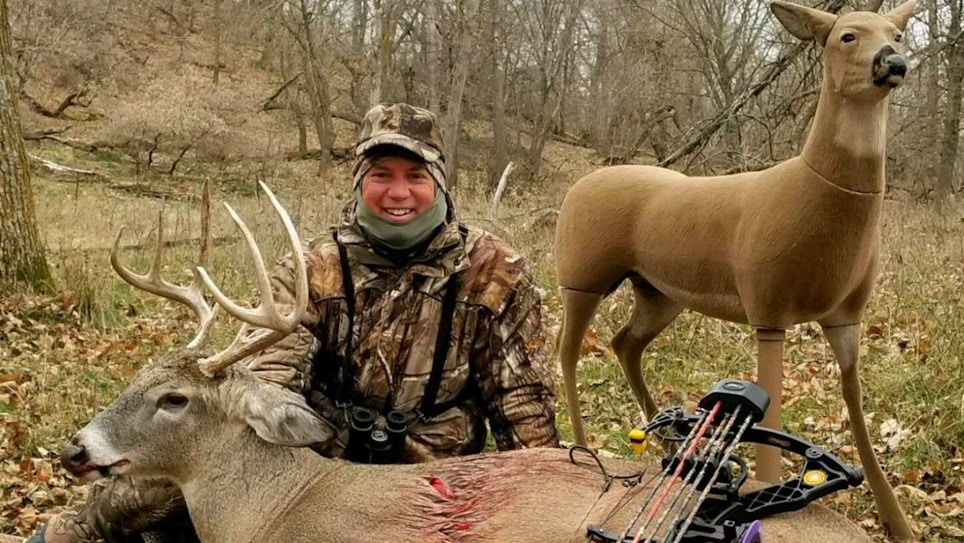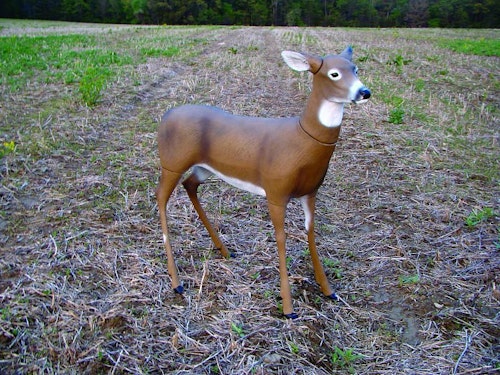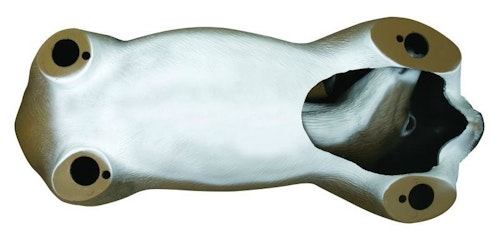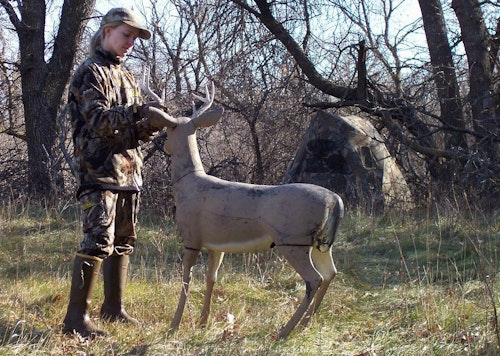There are few absolutes in deer hunting. That said, for me the one method that has come the closest to being foolproof is decoying whitetail bucks during the rut.
Before I dive deep into the details of my system, first let me say that the No. 1 concern with decoying deer is safety. I decoy deer ONLY on private land during archery season, and even then I’m careful to avoid placing a decoy (doe or buck) where it can be spotted from any road. In my opinion, it’s simply too risky to set a deer decoy where a poacher can find it in a riflescope and then send a bullet in my direction.
My Favorite Doe Decoy
There are several deer decoys on the market. On one end of the spectrum are lightweight and effective two-dimensional models such as those offered by Montana Decoy Company. On the other end are heavier, lifelike three-dimensional models; the Cadillac of them all is the Dave Smith Decoys Posturing Buck, which is priced at $649.99.
I own a handful of different deer decoys, and they’ve all worked for me at times, but in this article I’ll discuss the one system I use more than any other.
If you’re new to decoying deer and want to purchase one product, I have a specific recommendation: the Flambeau Boss Babe. This is a doe decoy, but you can add real antlers to it with a bit of work. (More on that later.) Nose to tail, this lightweight plastic decoy is 41 inches. From the tip of its ear to the ground, it’s 44 inches. In other words, she’s sized like a small yearling doe. MSRP on the Boss Babe is $162.16, but street prices are much less.
According to Flambeau, this decoy is based on a carving by award-winning sculptor Chris Schiller. I can confirm the Boss Babe looks real in the field, and I’ve killed numerous mature bucks that were mesmerized by her. Boss Babe has a wide stance, which means you don’t have to use stakes to keep her in place unless it’s very windy. In fact, I’ve never used stakes with this decoy; on those days when it’s blowing 30 mph or more, I’ll simply place the decoy over a blowdown and she stays put just fine.
As you can see from the Boss Babe photo above, she has a posture of a deer that is sort of squatting, almost like she’s ready to urinate. This is only my observation, but rutting bucks seem to think this doe is ready and willing to breed. When cruising rutting bucks spot her, they walk closer to check her out a high percentage of the time. I won’t guarantee success, but in my 45 years of bowhunting whitetails, I’ve yet to discover a better system.
In addition to the doe’s posture and ability to stand without stakes, I like the following features:
- head, legs and ears detach and fit in the body cavity for long hikes
- leg attachment design has threaded legs posts and locking lug nuts
- includes two sets of ears: submissive and alert (I use the submissive set)
- peg on rear leg for attaching scent pads
Keys to Success
The majority of the time, I use the Boss Babe solo. Sure, she works well in conjunction with a buck decoy, but carrying one decoy is a hassle, and carrying two (along with a bow) is impossible. The only time I’ve used her near a buck decoy (i.e. to mimic a breeding pair) is when I can drive my pickup or a side-by-side to the ambush spot prior to my hunt and then leave the two decoys stashed near my ground blind or treestand.
At times I’ve used the Boss Babe as a buck decoy. I drilled holes (about a quarter inch in diameter) in the top of the decoy’s head, then used real antlers with metal pegs in the pedicle ends (I used a thick nail section) to slide into the holes. I don’t use big antlers; see photo below. Note: I don’t think two antlers work any better than one for decoying, so when I change Boss Babe’s gender, I often use only one antler. It’s less to carry into the field. And who knows — perhaps bucks see the scrawny one-antlered yearling and march in because they know they’ll win the fight.
When using Boss Babe solo as a doe (almost always), I place her upwind or crosswind 17-20 yards from my stand. Usually I have her facing away from my stand, meaning bucks will approach her rear end, giving me a quartering-away shot as they slowly walk to her. After setting her in place, I spray doe-in-heat on her rump and legs, as well as on the ground between the decoy and my stand to cover my boot odor. I handle the decoy with gloves, not bare hands.

When using Boss Babe as a buck, I place him upwind or crosswind 15-17 yards from my stand, and I turn him toward me. Because bucks will approach him from the front, this gives me a quartering-away shot as they slowly walk to him. I use either doe-in-heat scent, or various buck odors, to help fool a whitetail’s nose.
Three More Decoying Tips
- Regardless of whether I’m using Boss Babe as a doe or buck, it helps to place it in the open so cruising rutting bucks can spot it from up to 100 yards. I especially like river-bottom pastures because they are relatively open but often have heavy bedding cover nearby, which means I can have rutting bucks action throughout the day.
- Be ready to grunt loudly or snort/wheeze at cruising bucks to help them spot the stationary decoy. After a buck spots it, you can stop calling and let them come in, often on a string.
- Don’t wait too long to draw your bow because the scene can turn into a rodeo if the buck charges/fights the buck decoy, or tries to breed the doe decoy. I like to draw when a buck is walking steadily toward the decoy setup and is still 30 yards away. This gives me plenty of time to find my anchor point, take a deep breath, track the buck with my pin, and then when he presents a broadside or quartering-away shot, I release my arrow. If he’s walking slowly at 10-17 yards, I don’t make a sound to stop him.
The video below gives you a good idea as to the size of the Boss Babe decoy and how it’s put together. Note: The host of the video has the ears placed on the wrong side of the decoy’s head. It’s a mistake I’ve made before, too, especially when assembling the decoy in the dark.
I encourage you to give decoying a try this fall on private land during archery season. In my opinion, it’s the most effective method for targeting rutting whitetail bucks.









